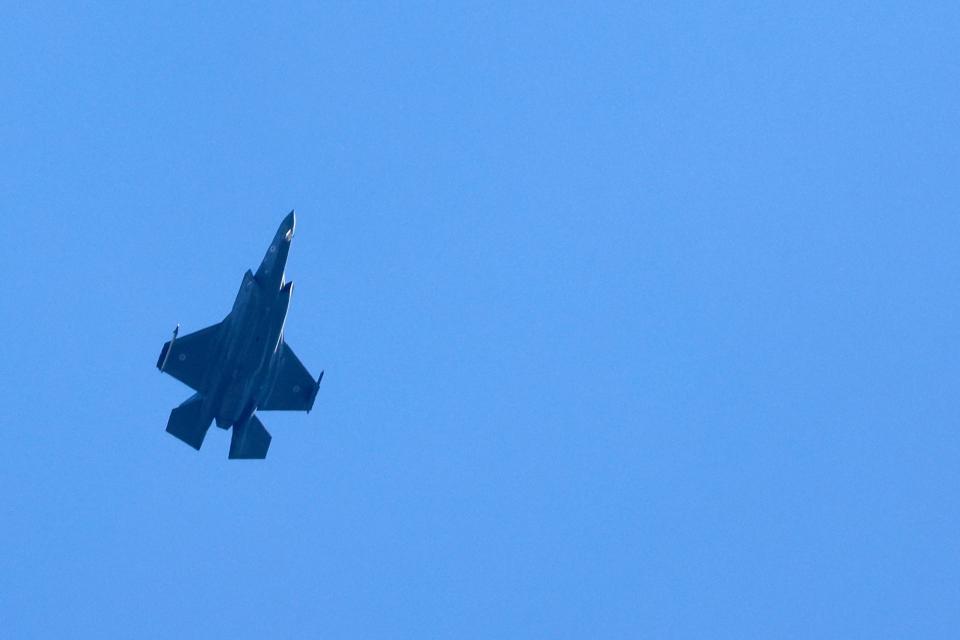The Israeli Air Force may have to think twice about taking on Hezbollah
Hezbollah may have surface-to-air missiles than can threat Israeli aircraft.
A recent Israeli strike appears to have damaged a Iran-made Sayyad-2 missile.
The possibility of missiles will "force" the IDF to be more cautious over Lebanon, an expert said.
Much has been written about Hezbollah's enormous arsenal of surface-to-surface missiles and rockets and the devastation they could unleash against Israel. A recent incident, however, briefly put the spotlight on Hezbollah's lesser-known air defenses.
After the Israeli Air Force targeted Hezbollah sites south of the Lebanese city of Sidon, footage emerged purportedly showing the remains of an Iranian-built Sayyad-2 surface-to-air missile. The Israeli military stated the Hezbollah sites targeted "posed a threat to Israeli aircraft."
Israeli media reported that the footage was "apparently the first public evidence suggesting that Hezbollah has such missiles," as had been previously claimed. Hezbollah has traded tit-for-tat strikes with Israel since Hamas' Oct. 7 terror attacks, but the air defenses suggest Israel's Air Force would face a much greater threat over southern Lebanon than it has in Gaza's skies.
The Sayyad-2 is a medium-range anti-aircraft missile Iran developed by heavily reverse engineering the American RIM-66 Standard Missile, SM-1, Tehran acquired before the 1979 revolution. The Sayyad-2 has a shorter range than its successors. The most advanced, the Sayyad-4B, which Iran developed for its Bavar-373 air defense system, has an estimated range of 186 miles.
In October, a Hezbollah-appointed guide showcased some of the group's firepower to visiting journalists and hinted they have long-range air defenses like the Russian S-300. "Do you think we don't have S-300?" he said. "If Iran has S-300, absolutely Hezbollah will take S-300."
It's unclear if Iran has tried to transfer the Bavar-373, Iran's domestically-developed equivalent to the S-300, to Hezbollah with its Sayyad 4/4B missiles.
"Hezbollah's air defense capabilities are very opaque," Nicholas Blanford, a non-resident senior fellow at the Atlantic Council and author of the 2011 book "Warriors of God: Inside Hezbollah's Thirty-Year Struggle Against Israel," told Business Insider. "More is known about other systems in their arsenal than air defense because Hezbollah very rarely uses it."
"Nevertheless, if Iran possesses or can acquire an air defense system that suits Hezbollah's needs, then it is safe to assume that Hezbollah probably will have it," Blanford said.
The Hezbollah expert also noted that possession of missiles like the Sayyad-2 "certainly raises the threat level" to Israeli aircraft compared to shoulder-fired missiles. He also pointed out that Israel has "always maintained" that any Hezbollah acquisition of advanced air defense systems amounts to a "red line."
Since 2013, Israel has sustained an air campaign in Syria targeting Iranian weapons shipments to Lebanon to prevent Hezbollah from acquiring high-end systems. It has intensified this campaign since the Hamas 10/7 attacks, likely making it more difficult than ever for Iran to transfer weapons to Hezbollah via Syria. During this campaign, Israeli jets have evaded and, at times, destroyed Syria's Russian-built short and medium-range Tor and Pantsir air defenses.
The discovery of the Sayyad-2 suggests Iran transferred at least some anti-aircraft missiles to its most valued regional proxy.
"It has been reported that Hezbollah possesses Sayyad-2 anti-aircraft missiles previously, and the Israeli strike on Friday solidified those claims," Freddy Khoueiry, a global security analyst for the Middle East and North Africa at the risk intelligence company RANE, told BI. "It was suspected that Hezbollah has been using the Sayyad-2 to shoot down some of Israel's advanced Hermes 900 drones over Lebanon."
"Hezbollah has for the past few years boasted of advancing its air-defensive capabilities, and the discovery of Hezbollah's possession of Sayyad-2 demonstrates how much they obtained advanced anti-air systems," Khoueiry said.

Israel has experience destroying formidable air defenses in Lebanon. When it invaded the country in 1982, it launched a coordinated, large-scale suppression of enemy air defense operation against an array of Soviet-built surface-to-air missile batteries Syria had deployed to Lebanon's Bekaa Valley.
Operation Mole Cricket 19 obliterated the Syrian missiles and saw Israel's new F-15 and F-16 fighters dogfight the Syrian Air Force, shooting down 82 Syrian aircraft without losing a single fighter.
While Hezbollah is unlikely ever to field a network of anti-aircraft missiles that large, some of its air defenses could nevertheless impact Israeli air operations over Lebanon.
"Generally speaking, this will unlikely deter Israel's Air Force from operating over Lebanon but will likely force the Israelis to become more cautious amid Hezbollah's changing tactics and their more advanced capabilities, such as having their fighter jets flying at higher altitudes or using stealthier jets like the F-35," Khoueiry said.
"Israel's Air Force is much more advanced and can bypass these air defenses, maintaining its immense air superiority, but Israeli drones and helicopters operating over Lebanon could be more at risk, especially if the IDF expands its operations in Lebanon."
Khoueiry doubts Iran will transfer strategic systems like the Bavar-373 to Lebanon.
"It is more likely that Iran can and did transfer medium-sized and range defensive systems to Hezbollah," Khoueiry said. "Larger anti-air defense systems like the Bavar-373 are harder to transfer given their size, but also given that Lebanon's geography is small and Hezbollah would not be able to properly operate them there."
The RANE analyst believes that if Iran did deploy the Bavar-373 in the region, it would send it somewhere like Syria, although he estimates that's unlikely at this point.
"The discovery of the Sayyad-2 likely hints that Iran has been able to transfer more similar advanced defensive systems that Hezbollah is likely to use in a progressive way as the conflict escalates or in the event of a wider war, especially given the likely limited number they possess," Khoueiry said.
Read the original article on Business Insider


